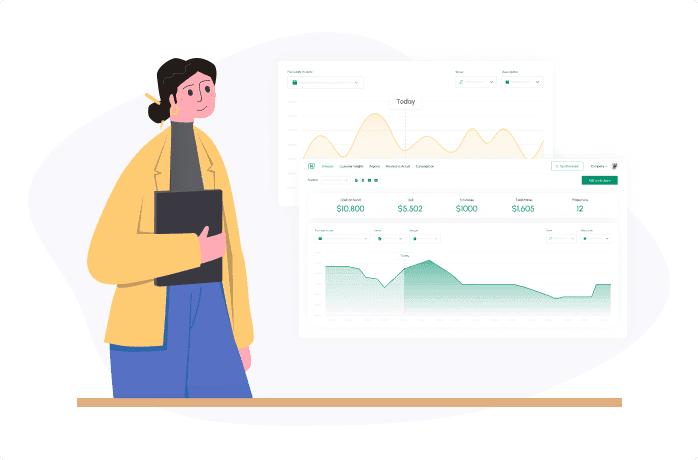What Are Debtor Days and How Do They Affect Your Cash Flow?

What is debtor days, and why does it matter to your business? At its core, this metric reveals how quickly your company turns outstanding invoices into actual cash. The longer customers take to pay, the more strain it puts on your cash flow, profitability, and overall financial health. That’s why understanding debtor days isn’t just helpful, it’s essential. In this article, we’ll break down what debtor days mean, why it’s crucial for managing cash flow, how to calculate it, and the best ways to keep it in check.
What Are Debtor Days?
The debtor day meaning is revealed by the measurement that shows the number of days it takes for businesses to collect payments from customers following invoice issuance. A business achieves faster invoice conversion to cash when it has fewer days of debtor accounts. Companies that provide credit to customers must monitor this metric because it reveals the period between completing sales and receiving payments.
The standard debtor days formula is:
Debtor Days = (Trade Receivables / Annual Credit Sales) × 365
Where:
- Trade Receivables = Outstanding invoices
- Annual Credit Sales = Total credit sales made (not including cash sales)
Example:
Your business has £120,000 in trade receivables and £800,000 in annual credit sales:
Debtor Days = (120,000 / 800,000) × 365 = 54.75 days
The average time to receive payment after completing a sale is nearly 55 days.
You can track debtor days more effectively by using the monthly debtor days formula:
Monthly Debtor Days = (Accounts Receivable / Monthly Credit Sales) × 30
A new business owner typically starts by asking
What are debtor days?What Is a Good Debtor Days Figure?
There is no universal answer to the question of what a good debtor days figure is, but businesses can use general benchmarks for reference. Most industries view a debtor days ratio below 30 as an excellent performance indicator.
For UK businesses, the debtor days calculation UK average typically ranges between 30-45 days for small to mid-sized companies. Wholesale and construction businesses may need to accept debtor days as high as 60. Understanding the debtor days meaning helps you set realistic expectations and financial targets
You should evaluate your financial performance against that of industry competitors to establish appropriate targets. Regular monitoring of debtor days helps maintain alignment between your cash flow strategy and prevents debtor days from increasing over time.
Where Debtor Days Show Up in Reporting
The calculation of debtor days depends on two main elements, which are accounts receivable from your balance sheet and total credit sales from your income statement.
Debtor days are included as standard key performance indicators (KPIs) in most contemporary accounting platforms. The metrics are displayed in management dashboards and monthly reports, which enable businesses to track trends and identify customers who are slow to pay. Financial institutions, along with auditors in the UK, use efficiency ratios, including debtor days, to evaluate a company's liquidity.
Why Are Debtor Days So Important?
There are several reasons why debtor days are important to understand:
Impact on Cash Flow
The length of time customers take to pay their debts directly shows how well your company converts sales into cash. The longer payment periods from customers create increasing pressure on your operational liquidity.
Example:
Your company has £100,000 in outstanding invoices with an average debtor days of 60. This means you are waiting two months to access money you have already earned, while expenses like rent and salaries are due sooner. This mismatch can force reliance on credit or overdrafts.
Signals for Financial Health
A low debtor days ratio is generally a good sign, as it suggests your business is efficient at collecting payments. High ratios may indicate the opposite: that your customers are unreliable, or that internal credit control processes are failing.
Financial analysts use debtor days as a tool to evaluate both creditworthiness and the financial discipline of a company. High debtor days , beyond industry averages , can create doubts among investors about your business.
Role in Credit Control Strategy
Debtor days serve as a strategic tool for credit control beyond their function as an accounting metric.
By monitoring the debtor days ratio formula regularly, you can:
- Identify late-paying customers
- Adjust payment terms accordingly
- Offer early payment incentives
- Apply penalties for habitual delays
In the UK, benchmarking your debtor days calculation against similar firms helps set realistic internal goals. A services firm might aim for under 30 days, while a wholesaler with higher invoice volumes may accept 45–50.
The combination of automated invoicing systems with reminder workflows and CRM-integrated finance tools enables better accounts receivable management, which shortens your average debtor collection period.

How to Reduce Debtor Days Without Breaking Relationships
Improving debtor days does not require aggressive tactics or putting client relationships at risk. In fact, with the right systems and communication, you can reduce your receivables period while maintaining a strong rapport and trust.
Set Clear Payment Terms Upfront
Many delays start with unclear or poorly communicated payment expectations. Set payment terms in writing at the proposal, contract, and invoice stages. Avoid vague phrases like “due upon receipt,” and instead use precise language such as “net 30 days from invoice date.”
Reinforce these terms on every invoice, in email follow-ups, and within any client onboarding documents.
Send Invoices Without Delay
The delay in sending invoices directly causes payment delays. Send invoices right away after delivering services or shipping products. The implementation of manual processes creates avoidable delays, so businesses should automate their operations whenever possible.
Most accounting systems provide automatic invoice triggering capabilities after job completion or milestone approval. These functions enable you to minimise the time gap between delivery and billing.
Automate Reminders for Upcoming and Overdue Invoices
A timely reminder helps prevent invoices from becoming overdue. Most customers maintain their intention to pay on time, but their busy schedules often cause delays. Your invoice should remain visible to customers through scheduled polite reminders, which should be sent before the due date , on the due date, and at regular intervals afterwards.
This type of communication builds reliability while preserving relationships.
Offer Small Incentives for Early Payment
A minor discount for payments made within 7 or 10 days can motivate clients to pay their invoices more quickly. Small changes in customer behaviour over time will produce substantial effects on cash flow while decreasing average debtor days.
Apply this approach to major clients and important invoices because faster payment processing will create more significant financial benefits.
Request Deposits for Long-Term Projects
If you provide services over weeks or months, consider billing a portion upfront. A deposit shows that the client is committed, and it prevents you from having 100% of the receivable sitting in your ledger for weeks.
You can structure payment in milestones to align invoicing with project progress. For example: 30% upfront, 40% mid-point, and 30% on completion.
Schedule Monthly Review of Aged Receivables
Dedicate specific time each month to check outstanding invoices while examining ageing reports. Begin by contacting clients through phone calls or direct messages when reviewing their overdue status, which falls into 30, 60, 90+ day categories. Use this opportunity to identify patterns: Are specific customers always late? Are certain industries slower to pay? Adjust your credit policy and risk assessments accordingly.
Debtor Days and Cash Flow: Direct Connection
One of the clearest financial lessons for any business is this: sales do not pay bills, cash does. The debtor day meaning is especially relevant here: longer waits for payment strain your cash position. And debtor days have a direct effect on when you can access that cash.
Here is why this matters:
- Longer debtor days delay reinvestment.
- Unpredictable collections hinder planning.
- Cash flow gaps increase financial costs.
This is why monitoring and reducing debtor days should be part of every cash flow improvement strategy.
Example:
A business with £250,000 in annual credit sales and average debtor days of 60 is effectively financing £41,667 of outstanding invoices at any given time: (250,000 / 365) × 60 = 41,096
Reducing the average by even 15 days would release approximately £17,123 into the company’s working capital.

Tools That Help You Track and Optimise Debtor Days
There are a number of tools that can help you optimise debtor days and simplify the process for yourself and your clients.
Integrated Accounting Software
Most accounting platforms come with built-in dashboards showing current debtor balances, overdue accounts, and average debtor days. They allow real-time tracking and automatic recalculation whenever a payment is recorded or an invoice is sent.
Look for software that supports:
- Automated recurring invoices
- Custom reminder scheduling
- Receivables ageing reports
- Exportable analytics for trends over time
Cash Flow Planning Tools
Cash flow forecasting tools offer visibility into how late payments impact your future financial position. These projections guide spending decisions and help prioritise collections. Set alerts for anticipated cash shortfalls due to delayed receivables so you can act before problems arise.
Customer-Level Insights
Not all customers behave the same. Use systems that provide client-specific reports showing:
- Days taken to pay per invoice
- Late payment frequency
- Total overdue balances
This allows you to adjust terms individually.
Embedded Payment Links
Making it easier to pay speeds up the process. Include clickable payment links or QR codes on every invoice. The fewer steps your client must take to pay you, the less likely they are to delay.
CRM and Payment System Integration
Modern accounting systems enable smooth integration with Customer Relationship Management (CRM) platforms, which provide an effective method to improve debtor tracking. The connection between customer profiles and invoicing systems enables automated functions to detect high-risk clients, customise payment reminders, and initiate escalation processes for late invoices.
Your debtor collection period becomes shorter through this approach, and you can customise credit terms for different customer groups, making your collections process faster and more intelligent.
Want to speed up collections and cut down your debtor days?
See how workMistakes to Avoid When Analysing Debtor Days
There are several mistakes that companies can make regarding debtor days, which can place them under unnecessary financial strain. Luckily, there are also easy ways to avoid these mistakes.
Using Only Year-End Data
Debtor days based on year-end receivables may not reflect normal performance. A single large invoice that remains unpaid on December 31st will distort your financial results.
Solution:
Use rolling averages across months or quarters to smooth out anomalies and better understand real trends.
Failing to Segment Data
The analysis of debtor days should focus on customer-specific data as well as project types and invoice dimensions to detect both major issues and simple opportunities.
Solution:
Break your data into categories. Examine debtor days by customer, by project type, or by invoice size to identify key areas for improvement and potential quick wins.
Ignoring Seasonal Fluctuations
The payment patterns of many industries change according to seasonal patterns. The failure to recognise these patterns results in targets that are unrealistic or causes unnecessary panic.
Solution:
Compare like-for-like periods. Use prior years’ seasonal averages to put spikes or dips in context.
Confusing DSO With Debtor Days
While many people use the terms interchangeably, understanding what is debtor days compared to DSO helps avoid confusion in reporting.
The calculation of debtor days measures the average duration needed to receive payments throughout an entire year. DSO (Days Sales Outstanding) functions as a short-term performance metric that businesses use to evaluate their performance on a monthly or quarterly basis.
Solution:
Understanding how to calculate debtor days is essential to forecasting cash flow and evaluating receivables risk.
Use the formula:
Debtor Days = (Trade Receivables / Annual Credit Sales) × 365
If your company has £90,000 in outstanding receivables and £600,000 in annual credit sales: Debtor Days = (90,000 / 600,000) × 365 = 54.75 This means it takes just under 55 days to get paid.
What Numbers Do You Need:
- Total credit sales (excluding cash sales)
- Average accounts receivable (from balance sheet or ageing report)
What Debtor Days Tell You About Your Customers
The debtor days ratio functions as a financial metric that provides valuable insights into customer payment patterns. The analysis of debtor days over time helps you identify which customers fulfil their payment obligations consistently, while also showing which customers need encouragement and which customers threaten your cash flow. You can analyse the debtor day meaning across different industries to adjust credit terms accordingly.
Work with clients who pay on different terms?
See how helpsWhat You Can Learn:
- Reliability: Do they consistently pay on time?
- Financial health: The client's delayed payments could indicate their financial difficulties.
- Administrative effectiveness: Repeated delays from a customer could indicate disorganisation rather than malicious behaviour.
- Suitability for credit terms: Some clients perform better with milestone billing or upfront deposits.
The analysis of debtor days calculation for individual clients or customer groups enables you to create separate billing strategies for each segment.
In Conclusion
Understanding what debtor days are is a fundamental part of managing your business’s financial health. The debtor days ratio directly affects your cash flow, together with your credit control and working capital. A high debtor days ratio restricts business expansion, but low ratios demonstrate effective operational management and collection abilities.
Regular use of the debtor days formula should be a standard practice for all business owners, including sole traders and finance managers, and members of larger accounting teams. Shortening your average debtor collection period allows you to access cash while minimising financial risks and enhancing your financial control.

Current Liabilities: Meaning, Examples, and How to Calculate Them
Read more

What Is a Finance Charge? A Simple Explanation You’ll Actually Use
Read more

Current Assets Explained: Meaning, Types, and How They Work
Read more

Cash Flow Forecasting Template
Read more

Your Guide To Financial Metrics And KPIs
Read more

10 Cash Management Trends for 2026
Read more
FAQ
Trusted by thousands of business owners
Start Free Trial Now